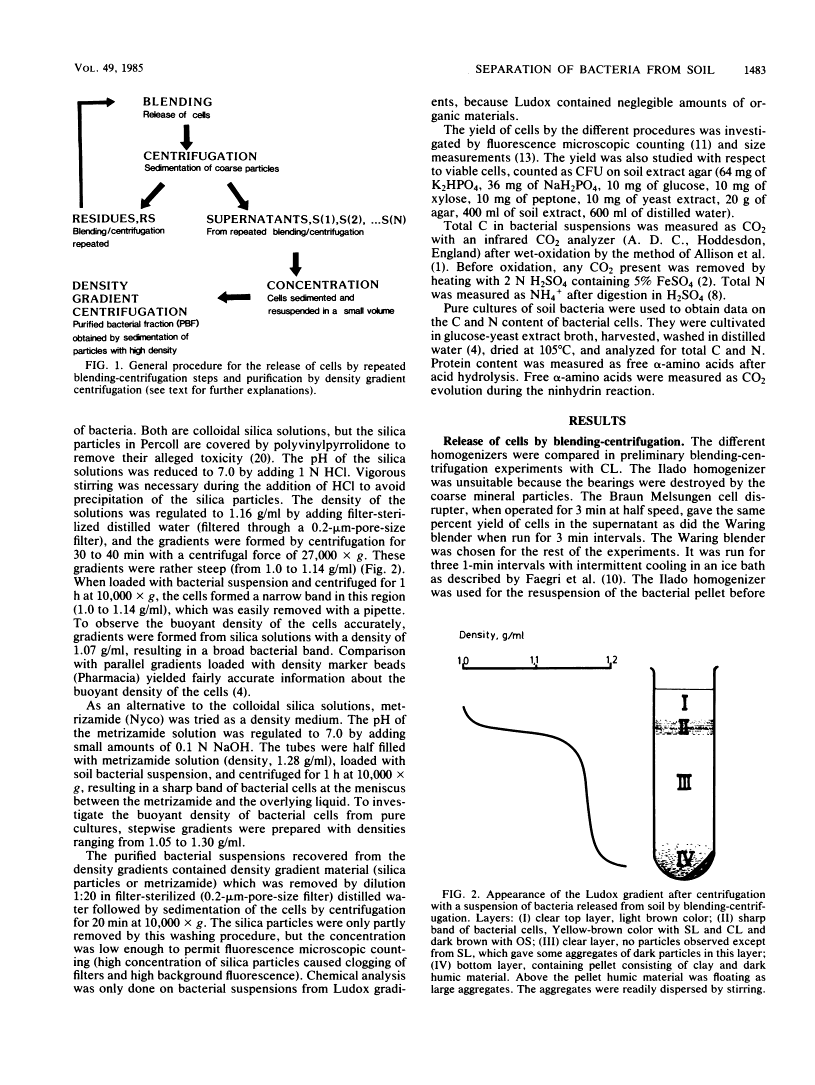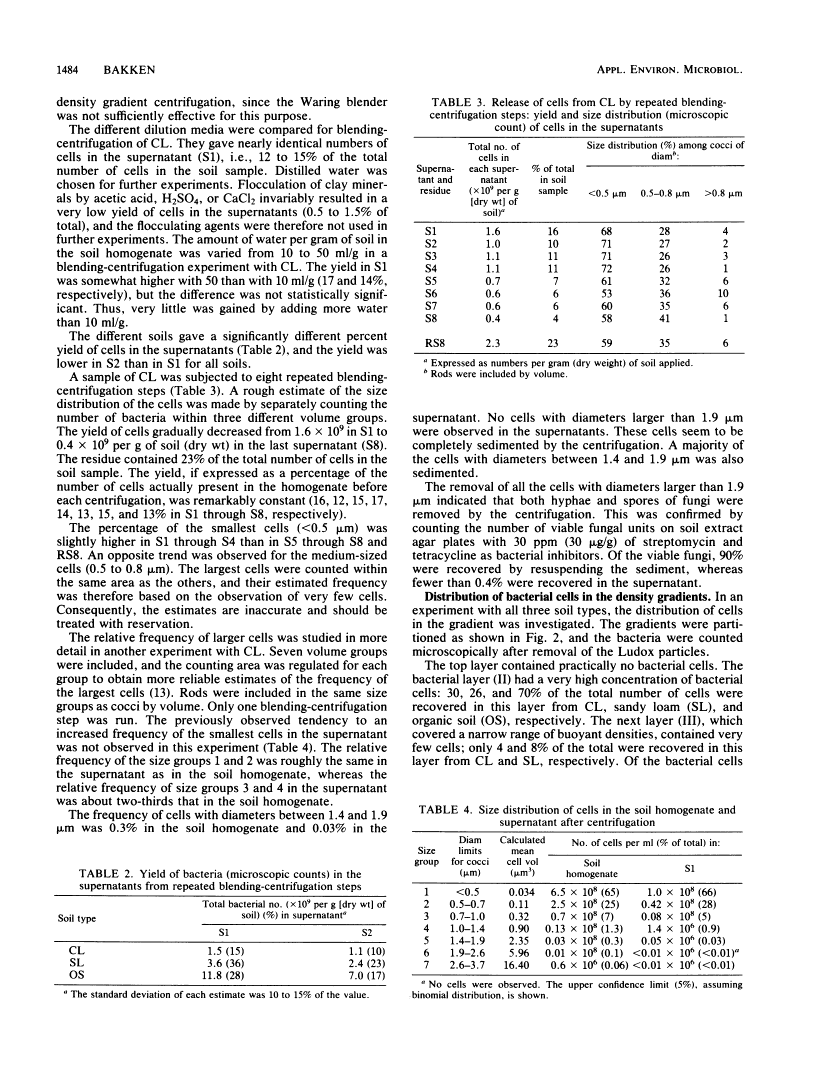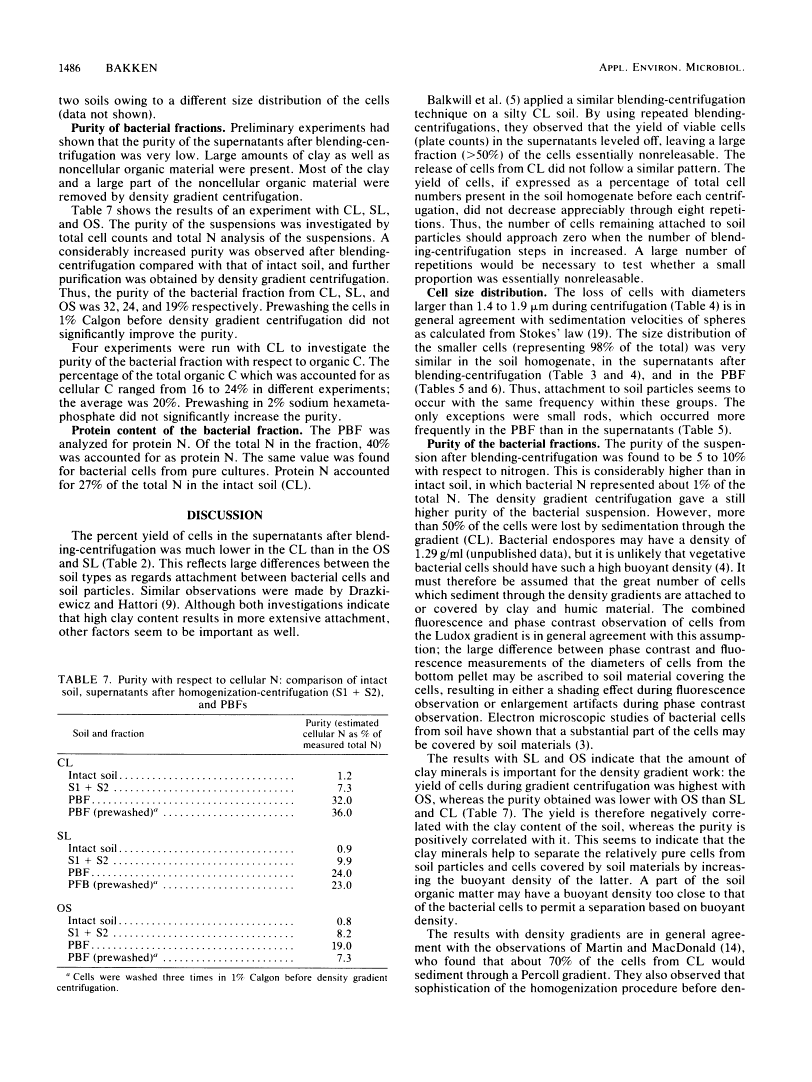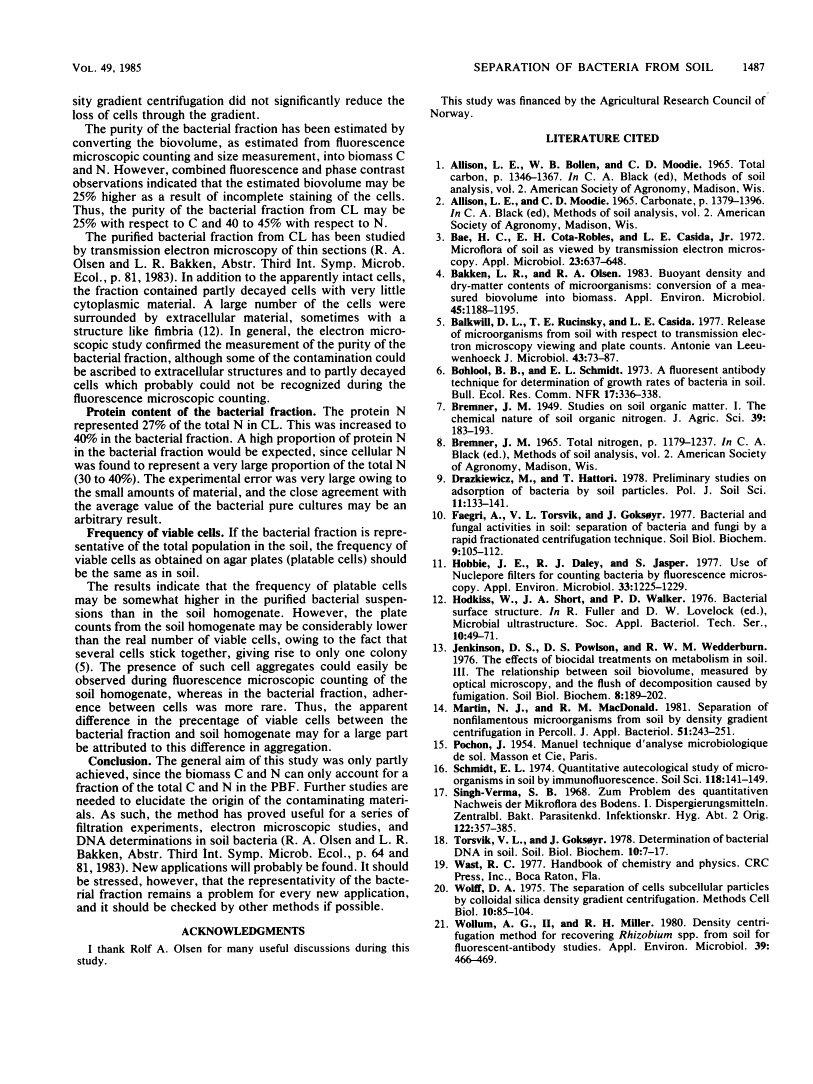Abstract
Free full text

Separation and Purification of Bacteria from Soil
Abstract
Bacteria were released and separated from soil by a simple blending-centrifugation procedure. The percent yield of bacterial cells (microscopic counts) in the supernatants varied over a wide range depending on the soil type. The superantants contained large amounts of noncellular organic material and clay particles. Further purification of the bacterial cells was obtained by centrifugation in density gradients, whereby the clay particles and part of the organic materials sedimented. A large proportion of the bacteria also sedimented through the density gradient, showing that they had a buoyant density above 1.2 g/ml. Attachment to clay minerals and humic material may account for this apparently high buoyant density. The percent yield of cells was negatively correlated with the clay content of the soils, whereas the purity was positively correlated with it. The cell size distribution and the relative frequency of colony-forming cells were similar in the soil homogenate, the supernatants after blending-centrifugation, and the purified bacterial fraction. In purified bacterial fraction from a clay loam, the microscopically measured biomass could account for 20 to 25% of the total C and 30 to 40% of the total N as cellular C and N. The amount of cellular C and N may be higher, however, owing to an underestimation of the cell diameter during fluorescence. A part of the contamination could be ascribed to extracellular structures as well as partly decayed cells, which were not revealed by fluorescence microscopy.
Full text
Full text is available as a scanned copy of the original print version. Get a printable copy (PDF file) of the complete article (1.2M), or click on a page image below to browse page by page. Links to PubMed are also available for Selected References.
Selected References
These references are in PubMed. This may not be the complete list of references from this article.
- Bae HC, Cota-Robles EH, Casida LE. Microflora of soil as viewed by transmission electron microscopy. Appl Microbiol. 1972 Mar;23(3):637–648. [Europe PMC free article] [Abstract] [Google Scholar]
- Bakken LR, Olsen RA. Buoyant densities and dry-matter contents of microorganisms: conversion of a measured biovolume into biomass. Appl Environ Microbiol. 1983 Apr;45(4):1188–1195. [Europe PMC free article] [Abstract] [Google Scholar]
- Balkwill DL, Rucinsky TE, Casida LE., Jr Release of microorganisms from soil with respect to transmission electron microscopy viewing and plate counts. Antonie Van Leeuwenhoek. 1977;43(1):73–87. [Abstract] [Google Scholar]
- Hobbie JE, Daley RJ, Jasper S. Use of nuclepore filters for counting bacteria by fluorescence microscopy. Appl Environ Microbiol. 1977 May;33(5):1225–1228. [Europe PMC free article] [Abstract] [Google Scholar]
- Singh-Verma SB. Zur Problem des quantitativen Nachweises der Mikroflora des Bodens mit der Methode Koch. I. Einfluss der verschiedenen Dispergierungsmittel und Verdünnungsmedien auf Bodendispersion und Gesamtkeizahl. Zentralbl Bakteriol Parasitenkd Infektionskr Hyg. 1968 Jul;122(4):357–385. [Abstract] [Google Scholar]
- Wolff DA. The separation of cells and subcellular particles by colloidal silica density gradient centrifugation. Methods Cell Biol. 1975;10:85–104. [Abstract] [Google Scholar]
- Wollum AG, Miller RH. Density Centrifugation Method for Recovering Rhizobium spp. from Soil for Fluorescent-Antibody Studies. Appl Environ Microbiol. 1980 Feb;39(2):466–469. [Europe PMC free article] [Abstract] [Google Scholar]
Associated Data
Articles from Applied and Environmental Microbiology are provided here courtesy of American Society for Microbiology (ASM)
Full text links
Read article at publisher's site: https://doi.org/10.1128/aem.49.6.1482-1487.1985
Read article for free, from open access legal sources, via Unpaywall:
https://aem.asm.org/content/aem/49/6/1482.full.pdf
Free to read at aem.asm.org
http://aem.asm.org/cgi/content/abstract/49/6/1482
Free after 4 months at aem.asm.org
http://aem.asm.org/cgi/reprint/49/6/1482
Citations & impact
Impact metrics
Article citations
Ranking environmental and edaphic attributes driving soil microbial community structure and activity with special attention to spatial and temporal scales.
mLife, 3(1):21-41, 26 Mar 2024
Cited by: 0 articles | PMID: 38827504 | PMCID: PMC11139212
Review Free full text in Europe PMC
Ex vivo comparison of V.A.C.® Granufoam Silver™ and V.A.C.® Granufoam™ loaded with a first-in-class bis-dialkylnorspermidine-terphenyl antibiofilm agent.
Biofilm, 6:100142, 11 Jul 2023
Cited by: 1 article | PMID: 37484784 | PMCID: PMC10359492
The Vaginal Microbiome: A Long Urogenital Colonization Throughout Woman Life.
Front Cell Infect Microbiol, 11:686167, 06 Jul 2021
Cited by: 28 articles | PMID: 34295836 | PMCID: PMC8290858
Review Free full text in Europe PMC
An Advanced Protocol for the Quantification of Marine Sediment Viruses via Flow Cytometry.
Viruses, 13(1):102, 13 Jan 2021
Cited by: 2 articles | PMID: 33451082 | PMCID: PMC7828538
A Maximum Subsurface Biomass on Mars from Untapped Free Energy: CO and H2 as Potential Antibiosignatures.
Astrobiology, 19(5):655-668, 05 Apr 2019
Cited by: 5 articles | PMID: 30950631
Go to all (100) article citations
Similar Articles
To arrive at the top five similar articles we use a word-weighted algorithm to compare words from the Title and Abstract of each citation.
[Effects of Soil Texture on Autotrophic CO2 Fixation Bacterial Communities and Their CO2 Assimilation Contents].
Huan Jing Ke Xue, 37(10):3987-3995, 01 Oct 2016
Cited by: 0 articles | PMID: 29964436
Effect of bovine manure on fecal coliform attachment to soil and soil particles of different sizes.
Appl Environ Microbiol, 73(10):3363-3370, 16 Mar 2007
Cited by: 17 articles | PMID: 17369341 | PMCID: PMC1907106
Flow cytometric measurements of cell volumes and DNA contents during culture of indigenous soil bacteria.
Microb Ecol, 29(1):49-62, 01 Jan 1995
Cited by: 20 articles | PMID: 24186638
Soft X-ray spectromicroscopy study of mineral-organic matter associations in pasture soil clay fractions.
Environ Sci Technol, 48(12):6678-6686, 04 Jun 2014
Cited by: 9 articles | PMID: 24837340











